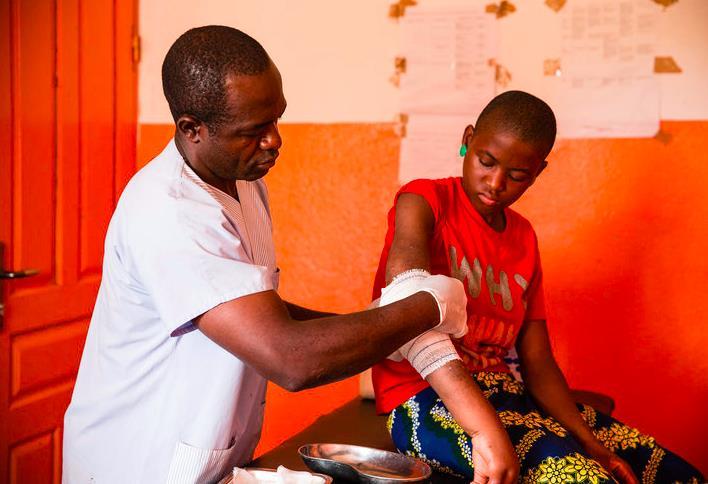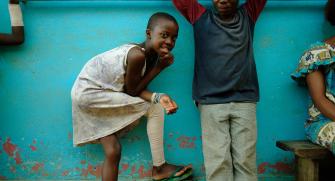Buruli Ulcer, a neglected disease
Origin and transmission of Buruli Ulcer
Like tuberculosis and leprosy, Buruli ulcer is caused by a type of mycobacteria (called Mycobacterium. ulcerans). The exact mode of transmission is unknown and still being investigated. It does not spread directly from one person to another. Some research suggests that in Africa aquatic insects can harbour the mycobacteria in their salivary glands. More recent studies suggest that a type of mosquito may be a vector; if this were confirmed, Buruli ulcer would be the only known mycobacterial disease to be transmitted by insects.
A disease that mainly affects West Africa

Buruli ulcer is mainly endemic in western Africa, although it has been reported elsewhere in Africa, the Americas, Asia and the Western Pacific. It is typically a focal disease, affecting communities living along slow-flowing water bodies such as ponds, swamps and lakes. The overall burden of Buruli ulcer can be seen as low, but the prevalence can be high in some areas, reaching 0.25% of the population, and countries such as Benin, Ivory Coast or Ghana report a few thousands of cases every year.
“It is believed that many cases go unreported due to limited knowledge of the disease, limited access to reliable diagnostic that is available only in few laboratories, its focal distribution and the fact that it affects mainly poor, rural communities.” Says Prof. Yap boum, epidemiologist at Epicentre and who is leading a study aimed at simplifying the diagnosis of buruli ulcer.
All ages and sexes are affected, but people with HIV and the young appear to be most at-risk, with most patients being under 15 years of age.
Symptoms of Buruli Ulcer
A chronic infection of the skin, Buruli ulcer usually starts with a nodule, plaque or edema that progressively develops into ulcer. Over time, it can lead to massive tissue destruction and debilitating deformities. The initial clinical manifestations are nonspecific and the disease has a slow course; many of those affected do not seek medical care until there is large skin necrosis requiring extensive surgery and prolonged hospitalization.
If untreated, Buruli ulcer can result in complications. Surgery, including extensive debridement, may be required to remove necrotic tissue, cover skin defects, and correct deformities. In extreme cases, amputation can’t be avoided. Buruli ulcer patients are also often victims of stigmatisation and ostracism in their communities. The stigma suffered by patients affects their mental health, they usually suffer from depression, suicidal desire, alcoholism and post traumatic syndrome.
The issue: improving the diagnosis of Buruli Ulcer
It is possible to make laboratory diagnoses by looking through a microscope for the presence of the mycobacteria in samples from the lesions, but this method is not very accurate as it found a bit more than one case out of two cases. Alternatively, diagnosis can be confirmed by growing the bacteria in a culture sample, or by relying on DNA amplification techniques known as PCR, but these are sophisticated tools that require access to a high-tech laboratory. Given that many of the people affected by Buruli ulcer live in remote or resource-poor settings with no access to laboratory services, these diagnostic tools are not widely available to those that need them most. The perception of medical staff towards patients with Buruli ulcer is also one of the factors that delays early diagnosis. Some feel stigmatized and prefer to go to traditional healers who treat them with more dedication. Care is also very expensive in specialized health centers. Very few health structures know how to deal with Buruli ulcer.
“What is needed is a simpler, more efficient diagnostic tool that could be used in the field, particularly in remote settings” says Prof. Yap Boum.
Clinical scoring does not require any diagnostic platform and could be adapted for settings with a very limited health infrastructure. Ideally, the scoring system should be so simple that it could be used by the traditional healers that most patients with lesions initially consult.
“A recent study done by Epicentre and MSF in Cameroon in partnership with the Ministry of Health of Cameroon, Fairmed, CIRES and the Centre Pasteur of Cameroon has validated a clinical score that can be used similarly by nurses and clinicians. This score can confirm 8 patients out of 10 patients diagnosed by PCR. It should be included in the upcoming guidelines on the management of chronic wounds globally” adds the epidemiologist.
Rapid diagnostic tests are still under development and their performance will be evaluated by 2021 in many African countries.
Advances in the treatment of Buruli Ulcer
Surgical intervention has been the main approach for the treatment of Buruli ulcer for many years. The WHO now recommends an 8 week course of oral antibiotics, rifampicin and clarithromycin. Oral antibiotic therapy has made the delivery of care for Buruli ulcer easier and treatment more accessible for patients despite the shortage of drug especially during the COVID-19 pandemic where antibiotic manufacturers seem to have shifted their production to azithromycin, leaving Buruli ulcer patients without treatment. There is solid evidence that early and limited lesions can be effectively treated with antibiotics alone, without any need for surgery and hospitalisation.
On top the antibiotics that are given to kill the Mycobacteria, modern dressings combining foam with a hydrogel component are applied to Buruli ulcers to clean and heal wounds, but also to prevent the pain and bleeding associated with gauze dressings.
Because of the important challenges faced by BU patients including stigmatization, depression and other mental health issues, their treatment should not be limited to wound care but should also include a psychological support that unfortunately is not available in most resources limited settings.
The traditional medicine represents an important part of Buruli ulcer treatment. In Cameroon, more than 80% of patients that were attending hospital for treatment of Buruli ulcer first consult a traditional healer. Their integration in patient management is key to ensure an adequate care and limit the delays in accessing medical care.
How to prevent buruli ulcer?
As the modes of transmission of the pathogen causing Buruli ulcer (e.g. M. ulcerans) are still unknown, it is currently very difficult to conceive and implement effective preventive strategies.
There are no vaccines against Buruli ulcer. A few studies have looked at the possible effect of BCG vaccination on the risk of Buruli ulcer, but no significant association could be found.
Permanent sensitization of populations living in endemic areas remain the main option:
- Wear boots and clothing covering the entire body when accessing to river that are thought to host the putative vector ;
- Avoid contact with the environment, in particular for farmers and fishermen in endemic regions or zones.
“Moreover, early consultation to the hospital with a better collaboration with traditional healers is paramount for an early management of Buruli ulcer patient to avoid the case of infirmity that we are seeing in our environment,” adds Yap Boum.
Towards a better patient care of Buruli Ulcer
The World Health Organization has supported the response in countries with the highest burden. Médecins Sans Frontières (MSF) and other NGOs have played a critical role to put the spotlight on Buruli Ulcer and demonstrate that simple interventions can make a difference and respond to the needs of patients. The recent integration of all skin NTDs – Buruli Ulcer, cutaneous leishmaniasis, leprosy, yaws and others – , in comprehensive programmes, should be able to strengthen the operational responses. This strategy should enhance detection of Buruli ulcer at earlier stages, which is crucial to reduce the need for surgery.
However, there is still a long way until Buruli ulcer can be effectively controlled. It remains a very neglected disease and awareness needs to be raised on its burden at both country levels and community levels. There are still many knowledge gaps, particularly on transmission and risk factors.
Moreover, community engagement and the integration of traditional healers in patient management are key steps towards stronger public health programmes against Buruli ulcer. In addition to more field programmes, there is also a need to develop more research projects for improve Buruli ulcer prevention, detection, wound care and psychological support given to patient.








